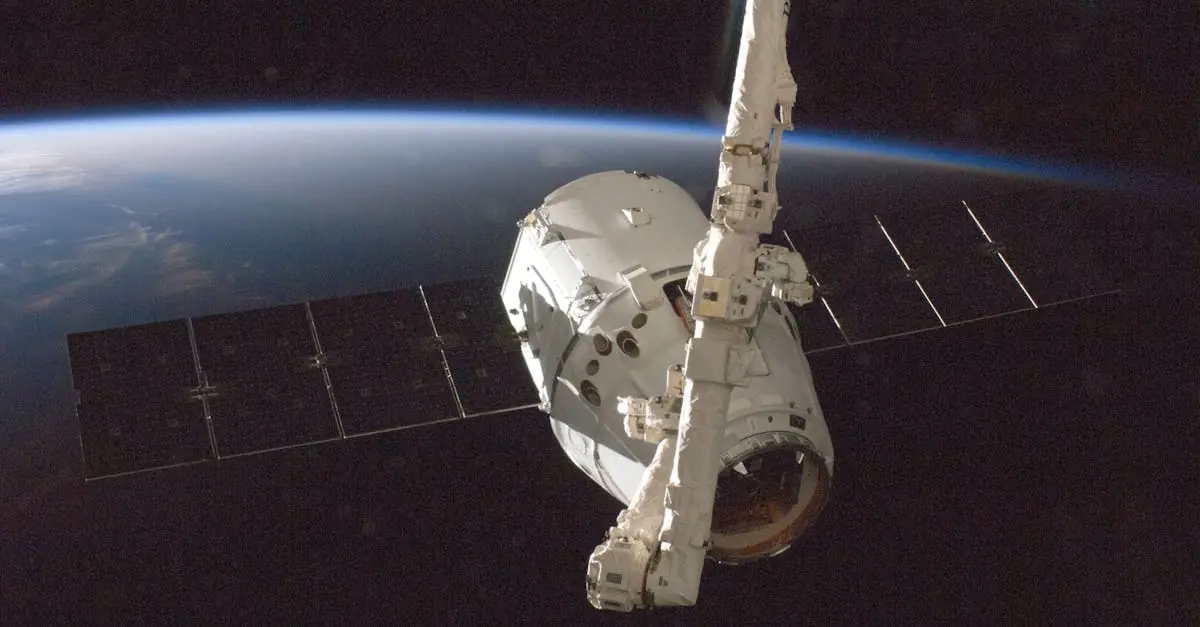Table of Contents
ToggleIn a world where every moment is a tweet away and GPS can guide you to the nearest taco truck, low Earth orbit satellites are the unsung heroes of our digital age. These high-flying gadgets zip around the planet at breakneck speeds, delivering everything from internet connectivity to advanced weather forecasts. Who knew that a metal box spinning hundreds of miles above our heads could have such a profound impact on our daily lives?
Overview of Low Earth Orbit Satellites
Low Earth orbit satellites operate at altitudes between 180 and 2,000 kilometers above the Earth’s surface. These satellites travel at speeds of approximately 28,000 kilometers per hour, enabling them to complete one orbit in around 90 minutes. Key advantages include reduced latency in communication and enhanced image resolution for Earth observation.
Communication networks greatly benefit from low Earth orbit satellites. These systems provide internet services to remote and underserved areas, bridging the digital divide. In addition, they support various sectors, such as telecommunications, broadcasting, and military operations.
Weather forecasting improvements stem from the data collected by low Earth orbit satellites. High-resolution imagery assists meteorologists in tracking storm patterns and predicting severe weather events. As a result, early warning systems become more effective, saving lives and minimizing property damage.
Satellite constellations consist of multiple low Earth orbit satellites working together. For example, SpaceX’s Starlink and OneWeb use this approach to enhance global internet connectivity. Such networks ensure consistent coverage, allowing users worldwide to access reliable services.
Innovations in satellite technology continue to shape low Earth orbit applications. Miniaturization trends lead to the development of small satellites, or CubeSats. These smaller systems reduce launch costs and increase accessibility for research and commercial purposes.
Through advancements in technology and collaborative efforts, low Earth orbit satellites play a critical role in digital infrastructure and data collection. Their contributions significantly impact daily life, providing services that many may take for granted.
Applications of Low Earth Orbit Satellites
Low Earth orbit satellites play a vital role across various sectors, delivering essential services that enhance daily life and scientific understanding.
Communication Services
Communication services benefit significantly from low Earth orbit satellites. They provide internet access to remote and underserved areas. With lower latency compared to geostationary satellites, data transmission occurs more quickly. These satellites support telecommunications, broadcasting, and military applications. Starlink and OneWeb represent notable constellations improving global connectivity, ensuring consistent coverage despite geographical challenges. High-speed internet availability transforms industries and strengthens social connections for millions.
Earth Observation
Earth observation capabilities are another prominent application of low Earth orbit satellites. They enable detailed monitoring of environmental changes and natural disasters. Enhanced image resolution allows for more accurate analyses of land use, deforestation, and urbanization. Meteorologists rely on this data to track storm patterns and assess weather conditions. By improving weather forecasting accuracy, these satellites contribute to public safety and disaster preparedness. Organizations utilize satellite imagery for research, policy-making, and addressing climate change.
Scientific Research
Scientific research thrives with the assistance of low Earth orbit satellites. These satellites collect vast amounts of data, helping scientists explore various phenomena. Research projects focus on climate monitoring, atmospheric studies, and space weather analysis. Data gathered from these satellites is crucial for developing new technologies and understanding our planet. Collaborative efforts among universities, governments, and private entities foster innovation in satellite design and deployment. Consequently, scientific knowledge advances, benefiting society as a whole.
Advantages of Low Earth Orbit Satellites
Low Earth orbit satellites provide several compelling benefits that enhance their utility across various sectors. These advantages include proximity to Earth and cost-effectiveness, which contribute significantly to their operations and applications.
Proximity to Earth
Proximity to Earth reduces communication latency for low Earth orbit satellites. At altitudes ranging from 180 to 2,000 kilometers, signals experience minimal delay, enhancing real-time interactions. Clear advantages exist for applications requiring swift data relay, such as internet communications and emergency services. Earth observation also sees benefits; high-resolution images capture precise changes on the planet’s surface. Consequently, industries like agriculture rely on timely satellite data for operational decisions.
Cost-Effectiveness
Cost-effectiveness emerges as a key advantage for low Earth orbit satellites. Launching these satellites incurs lower costs compared to higher-altitude satellites. Smaller, lightweight designs reduce both manufacturing and deployment expenses. Companies, including startups, can enter the satellite market more easily. This accessibility fosters innovation and competition, leading to enhanced services that cater to diverse user needs. Furthermore, ongoing advances in technology continually aim to decrease operating costs, reinforcing the viability of low Earth orbit satellites in various applications.
Challenges Facing Low Earth Orbit Satellites
Low Earth orbit satellites encounter several challenges that can affect their operations and longevity.
Space Debris
Space debris presents a significant threat to low Earth orbit satellites. Over 25,000 pieces of debris, including defunct satellites and spent rocket stages, orbit Earth. Collisions with these objects can damage or destroy functioning satellites. Risks increase as the number of satellites in orbit rises, with thousands planned for deployment in the coming years. Tracking and predicting the movement of debris becomes essential for ensuring satellite safety. Mitigation strategies, such as designing satellites for end-of-life disposal, are crucial in addressing this growing concern.
Regulatory Issues
Regulatory hurdles complicate the operation of low Earth orbit satellites. Different countries impose varying regulations on satellite launches and operations, creating challenges for global projects. Licensing, frequency allocation, and ensuring compliance with international treaties require significant administrative efforts. Collaboration among nations becomes necessary to create a streamlined framework that fosters innovation while ensuring responsible usage of orbital resources. Agencies like the Federal Communications Commission in the U.S. play critical roles in managing these regulatory landscapes to support satellite deployment and operational sustainability.
Future Trends in Low Earth Orbit Satellites
Emerging technologies are significantly shaping the future of low Earth orbit (LEO) satellites. Increased demand for global internet coverage drives expansion in satellite constellations. SpaceX’s Starlink and OneWeb continue to provide widespread service, enhancing connectivity in remote regions. Growth in applications for high-speed internet access highlights the necessity for rapid deployment of these networks.
Artificial intelligence integration also becomes more prevalent in satellite operations. AI enhances data processing capabilities, resulting in quicker decision-making and improved accuracy in monitoring environmental changes. New algorithms help in analyzing the vast amounts of data collected from Earth observation, enabling scientists to anticipate natural disasters and optimize resource management.
Collaboration among organizations aids in advancing satellite technology. Partnerships between space agencies and private companies foster innovation in satellite design and launch strategies. This collaborative spirit pushes the boundaries of current satellite capabilities, driving the development of miniaturized satellites that can deliver similar services at lower costs.
Sustainability practices also take center stage as the industry responds to growing concerns about space debris. Implementing end-of-life disposal plans and designing de-orbiting systems minimize debris accumulation. Regulators and industry leaders work together to create policies that ensure responsible usage of space resources while promoting innovation.
Investment in satellite technology continues to rise. Increased funding leads to research in next-generation propulsion systems and materials that enhance satellite durability. These advancements ensure longer operational life and better performance in LEO, positioning satellites for sustained contributions to global infrastructure.
Shifts toward private sector involvement present both opportunities and challenges. Competitive dynamics among new entrants drive innovation but also complicate regulatory frameworks. Ensuring that all operators comply with safety standards and environmental considerations remains critical as the sector evolves.
Conclusion
Low Earth orbit satellites are reshaping the way society interacts with technology and the environment. Their ability to provide reliable internet access and accurate weather forecasting is transforming lives and industries. As advancements in satellite technology continue to emerge, the focus on sustainability and responsible usage of orbital resources becomes increasingly crucial.
The challenges posed by space debris and regulatory complexities require collaborative efforts to ensure the longevity and safety of these satellites. With ongoing innovations and partnerships, the future of LEO satellites looks promising. They will play a pivotal role in bridging connectivity gaps and enhancing our understanding of the planet. As these technologies evolve, they will undoubtedly continue to make significant contributions to global communication and scientific research.




